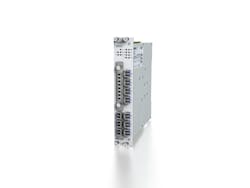ADVA Optical Networking has come through on its long-promised lower-cost alternative to DP-QPSK with coherent detection for metro applications. A company source says ADVA is sampling a new line card that transmits 100 Gbps up to 500 km within a 200-GHz superchannel that comprises four 28-Gbps carriers.
The card, which is two slots wide and 5 RUs high, fits into existing ADVA FSP 3000 metro platforms. It pulls less than 100 W and offers a 2.5X improvement in spectral efficiency versus 10 wavelengths of 10 Gbps at roughly the same cost, the company asserts.
The 100-Gbps transmission also can be carried as an alien wavelength by platforms from other vendors, says Jim Theodoras, ADVA’s senior director of technical marketing, as long as those platforms can accommodate 200-GHz superchannels. The 100-Gbps transmission also can run safely alongside lower-speed wavelengths on the same fiber, he says.
The four 28-Gbps channels are produced via a specially designed transponder packaged in a CFP format. The resultant signals leverage optical duobinary modulation, a technology popular in the first generation of fielded 40-Gbps systems. Theodoras says ADVA “turned to our supply chain” to create the transponder, which the company paired with in-house latency-reducing digital processing electronics on the line card. Theodoras declined to identify the partners with whom ADVA worked.
Theodoras says his company will make the line card generally available later this year.
While the company has embraced DP-QPSK with coherent detection for long-reach applications, ADVA has made no secret of its desire for a more economical alternative for price-sensitive metro applications. The company at one time touted a modulation format called DPSK-3ASK (see “ADVA demos serial 100G transmission for metro/regional applications”). Theodoras says work on this modulation format was part of a three-pronged approach. The 4x28-Gbps approach initially was targeted at applications of around 200 km, DPSK-3ASK for applications approaching 600 km, and DP-QPSK with coherent detection for long haul and ultra-long haul.
The DPSK-3ASK technology worked fine, Theodoras says. However, the 4x28-Gbps approach proved to be viable over longer reaches than anticipated, which the price of DP-QPSK with coherent detection has gone down enough to make it economically viable for reaches shorter than expected. DPSK-3ASK thus was squeezed out, he explains.
The use of multiple carriers to transmit high data rates is not unusual. Vello Systems, in its original OpVista incarnation, used what it called “Dense Multicarrier technology” to squeeze multiple 10-Gbps carriers into the spectrum normally assigned to a single 10-Gbps wavelength (see “OpVista unveils its 40/100G technology”). In fact, Vello Systems touts 100-Gbps capabilities on its current CX16000 platform (see “Vello Systems picks up where OpVista left off with CX16000”). Meanwhile, Nortel’s original commercial DP-QPSK systems transmitted 100 Gbps in the form of two 50-Gbps subcarriers.
For more information on high-speed transmission systems and suppliers, visit the Lightwave Buyers Guide.
